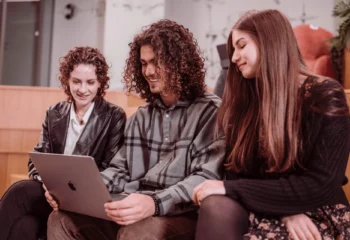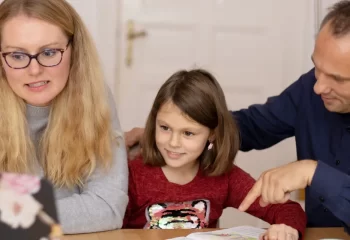This article is part of the Social Interaction in Schools Guide. Learn all about Social Interaction Skills in Education, Student to Student Interaction, and Teacher to Student Interaction.
Social interaction happens daily. Each social environment is different, and we have to communicate each time differently. However, the basics are the same, and it is essential to know them. Our family, community, culture and education at home and school play a vital role in developing our social interaction skills.
Social interaction in the classroom basics
In a classroom environment, the social interaction happening is done with colleagues of the same or appropriate age as you and with the teachers and mentors. As school is where young people spend half of their day, this is a great environment where they can develop and practice their social interaction skills.
Social skills are best learned when a multitude of means is used. And this is mostly because students cannot be all the same and have the same needs and perceptions. Thus there is no right or wrong way to teach social skills, but if you want them to appeal to each student, using various means of integrating social skills in the classroom is the best. Using tools such as storytelling, role-playing, groups exercises, peer observing, and multimedia can be a great way to enhance the social skills of a broader range of students.
Why is it Important?
Social interaction is essential as it helps students form relationships, build trust with themselves and others, understand different topics, learn new things, and develop socially and cognitively.
Inside a classroom environment, social interaction helps students have positive outcomes from their interactions, understand the behaviours of the other colleagues and be an active part of a discussion – whether listening or talking.
Social interaction is a great tool to learn.
Moreover, there is no difference between social status, ethnic group, or origin when socially interacting.
What are the benefits?
The benefits of social interaction go beyond the interaction rules.
Social interaction helps students and everyone involved have a healthy life; it helps them maintain good mental and physical health. Once you know how to communicate and understand others, it is easier to accept them, their opinions and their needs.
Social interaction is essential for a child’s mental and physical well-being, and it helps in the learning process.
Being open about social interaction and making the most of it can help students
– Develop their interpersonal skills.
– Gain self-confidence.
– Surpass their shyness.
– Have a positive attitude towards school.
– Feel connected with their colleagues and supported as they are free to discuss the lessons, courses, and homework, thus sharing experiences between themselves.
Success comes easier inside a group with cohesion, where students communicate directly with one another and understand each other’s needs. This helps them release the workload they might feel they have. Once social interaction is established, the increased cohesion of students allows them to create groups and feel a part of one.
– Increases students’ thinking capacity.
Interpersonal skills help students see the need of others when communicating and also allows them to make decisions on how and what to say. It is a great way to grow relationships, show their understanding, and receive positive outcomes from interacting with others.
More than the benefits social interaction has among students; it also offers benefits such as:
– It creates norms as far as learning is concerned.
– Helps students cope with challenges as far as teaching concerns.
– Develops students’ personalities as they continue to grow their interaction skills and discover various aspects of their personality.
Social interaction classroom activities for high school students
The teacher gives the students a topic and the objective he wants to achieve. Then students are grouped, and they have to discuss the topic until they come up with various findings. While the instructor/teacher is the one that makes sure the students interact and communicate, inside the group, there has to be someone taking notes, someone leading the discussion and the team that participates in findings. Thus, they develop social interaction skills like negotiating, compromising, delivering an idea, and presenting.
Another way of implementing social interaction in classroom activities is the social stories. These are great for students as they allow students to have, let’s say, kind of a script about certain situations.
Social interaction classroom activities for middle school students
Middle school teachers should create a communication culture with a collaborative learning community. Teachers tend to generate an order type of teaching in the classroom to keep middle school students listening. However, it creates chaos and unwillingness to cooperate and communicate.
This will allow students to be a part of creating their norms, take on social responsibility and develop friendships.
Multimedia tools come in handy when adding social interaction to the classroom. These can be – videos, virtual environments, pictures etc. Multimedia tends to help those students that are more visual learners. While not necessarily the most recommended tool, this can help students who face disabilities.
Parents’ involvement in school activities with their middle school children has a significant impact on enforcing social interaction skills.
Social interaction classroom activities for elementary students
A social language that becomes part of the classroom culture in elementary school is vital. This means just using familiar ways and words to communicate with others – listening, apologising, respect.
A fantastic social interaction idea for elementary school students is reading and discussing children’s literature. Many of the books destined for children have stories that include the social interaction topics – making new friends, discovering new situations, etc. From being a part of this universe, children learn how important having social interaction skills is.
At this age, children can also be taught social interaction skills through turn-taking and pretend play: “Watch this,” and “Did you see that!?!”
Promoting social interaction among students
Social interaction is at every step during school hours. However, inside a more formal environment, social interaction begins when the teacher/ tutor introduces the subject of discussion and the objective they need to reach.
Once social interaction strategies are promoted, students develop their abilities to speak up, listen, understand and trust themselves and others.
There are cases when social interaction cannot help when there is a big difference between people’s motivations within a group. There are challenges as far as the likes of others are concerned, differences that exist between the desires of each group participant and the strategies they use to achieve the objective.
Positive Peer Interaction
Social interaction helps increase positive interactions between students and peers, and eventually, it leads to a successful academic life. These interactions imply self-regulation, active listening, cooperation and effective communication. As long as the basis of the above exist, students can have positive peer interactions.
A positive peer interaction involves identifying and studying real-world problems, interacting with classmates, and using project-based learning.
Interactive Learning Centers
“Just as a listener tunes into a speaker, a teacher must observe, listen to and tune into a learner. Being sensitive to the learner’s thinking allows the teacher to draw the child’s attention to many things. The teacher, in conversation with the child creates opportunities for the child to talk, and to talk more.” (The Role of Powerful Language Interactions in Reading Recovery Lessons)
Free Play
There is nothing like playing to help students learn. Playing offers children the freedom to choose how to play, with whom and what to play.
Conclusion
Social interaction skills grow students into being ready for their professional life. It will help them communicate with colleagues, better understand and comply with the rules, and create relationships.
Social interaction in the classroom is essential because it helps children enjoy being in a social environment and participate in activities that will help them learn more.
Social Interaction in the Classroom FAQ
How do you implement social interaction in the classroom?
Inside the classroom, social interaction depends a lot on the teacher and how the teacher sees the availability of the students to combine lessons with socialising. However, an experienced teacher can easily mix the two when creating communication paths with students, open questions, allow students to lead the idea where the lesson leads, and offer multimedia guides and other tools that enav]ble teachers to keep the communication alive.
Why is social interaction significant in the classroom?
Social interaction is an everyday tool that people use to connect, exchange ideas, learn, grow and form relationships. Social interaction can help students use their learned skills and create long-lasting friendships in a classroom environment.
What is an example of social interaction?
A great example of social interaction in the classroom is sharing ideas on something the entire class read.
What are the types of interaction in the classroom?
Some of the interaction types can be
– Talking
– Viewing a movie
– Sharing ideas about a topic
– Solving a problem
– Roleplaying




